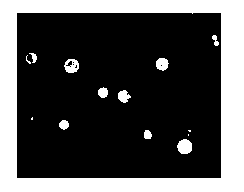Ultralow temperature preservation method and activity identification method for cardiocrinum giganteum var. yunnanense protoplast
A technology of cryopreservation and protoplasts, applied in the field of cell preservation of plant germplasm resources, to achieve the effect of ensuring genetic stability and survival rate
- Summary
- Abstract
- Description
- Claims
- Application Information
AI Technical Summary
Problems solved by technology
Method used
Image
Examples
Embodiment 1
[0027] The cryopreservation method of the protoplasts of Dalilia yunnanensis:
[0028] 1. Callus induction: use the immature embryos germinated from the seeds of Dalilia yunnanensis collected from Ailao Mountain in Yunnan Province as explants, wash the explants with water, soak them in 75% alcohol for 30 s, and then wash them with 0.1% alcohol mercuric chloride for 5 min, rinsed with sterile water for 3 times, and inoculated the sterilized explants on callus induction solid medium: MS+2mg / L KT+1mg / L 2,4-D+3% sucrose +0.7% agar powder, cultured in the dark at 23°C; callus was induced after 40 days. The medium was autoclaved at 121°C for 20 minutes;
[0029] 2. Separation of protoplasts from Dalilia yunnanensis: Take 1g of the above callus on the ultra-clean workbench, cut into about 0.2-0.3cm 2 Put the small pieces in a 10mL centrifuge tube, add the enzyme solution at a ratio of 1:10 between the material and the enzyme solution, and enzymatically hydrolyze it in the dark at 25°...
Embodiment 2
[0040] 1. Callus induction: use the immature embryos germinated from the seeds of Dalilia yunnanensis collected from Ailao Mountain in Yunnan Province as explants, wash the explants with water, soak them in 75% alcohol for 30 s, and then wash them with 0.1% alcohol mercuric chloride for 5 min, rinsed with sterile water for 4 times, and inoculated the sterilized explants on callus induction solid medium: MS+3 mg / L KT+2 mg / L 2,4-D +3 % sucrose + 0.7% agar powder, cultivated in the dark at 27°C; callus was induced after 40 days. The medium was autoclaved at 121°C for 20 minutes;
[0041] 2. Isolation of protoplasts from Dalilia yunnanensis: Take 2g of the above callus on the ultra-clean workbench, cut into about 0.3cm 2 Put the small pieces in a 10mL centrifuge tube, add the enzyme solution at a ratio of 1:15 between the material and the enzyme solution, and dissociate in the dark at 28°C for 12 hours, and occasionally shake it gently a few times during the process. Among them,...
Embodiment 3
[0052] 1. Callus induction: use the immature embryos germinated from the seeds of Dalilia yunnanensis collected from Ailao Mountain in Yunnan Province as explants, wash the explants with water, soak them in 75% alcohol for 30 s, and then wash them with 0.1% alcohol mercuric chloride for 5 min, rinsed with sterile water for 3 times, and inoculated the sterilized explants on callus induction solid medium: MS+2 mg / L KT+2 mg / L 2,4-D +3 % sucrose + 0.7% agar powder, cultured in the dark at 25°C; callus was induced after 40 days. The medium was autoclaved at 121°C for 20 minutes;
[0053] 2. Isolation of protoplasts from Dalilia yunnanensis: Take 1.5g of the above callus on the ultra-clean workbench, cut into about 0.2cm 2 Put the small pieces in a 10mL centrifuge tube, add the enzyme solution at a ratio of 1:10 between the material and the enzyme solution, and enzymatically digest it in the dark at 28°C for 9 hours, and occasionally shake it gently a few times during the process. ...
PUM
 Login to View More
Login to View More Abstract
Description
Claims
Application Information
 Login to View More
Login to View More - R&D
- Intellectual Property
- Life Sciences
- Materials
- Tech Scout
- Unparalleled Data Quality
- Higher Quality Content
- 60% Fewer Hallucinations
Browse by: Latest US Patents, China's latest patents, Technical Efficacy Thesaurus, Application Domain, Technology Topic, Popular Technical Reports.
© 2025 PatSnap. All rights reserved.Legal|Privacy policy|Modern Slavery Act Transparency Statement|Sitemap|About US| Contact US: help@patsnap.com



